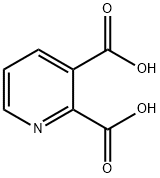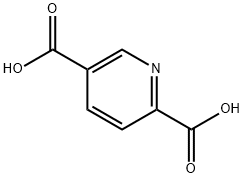A6854912
2,3-Pyridinedicarboxylic acid , 98% , 89-00-9
Synonym(s):
Quinolinic acid
CAS NO.:89-00-9
Empirical Formula: C7H5NO4
Molecular Weight: 167.12
MDL number: MFCD00006295
EINECS: 201-874-8
| Pack Size | Price | Stock | Quantity |
| 25G | RMB35.20 | In Stock |
|
| 100G | RMB80.00 | In Stock |
|
| 500g | RMB319.20 | In Stock |
|
| others | Enquire |
Update time: 2022-07-08
PRODUCT Properties
| Melting point: | 188-190 °C (dec.) (lit.) |
| Boiling point: | 295.67°C (rough estimate) |
| Density | 1.5216 (rough estimate) |
| refractive index | 1.6280 (estimate) |
| storage temp. | Keep in dark place,Sealed in dry,Room Temperature |
| solubility | 10g/l |
| form | Crystalline Powder |
| pka | 2.43(at 25℃) |
| color | White to light yellow-beige |
| Odor | odorless |
| Water Solubility | 0.55 g/100 mL |
| Merck | 14,8073 |
| BRN | 137110 |
| InChIKey | GJAWHXHKYYXBSV-UHFFFAOYSA-N |
| CAS DataBase Reference | 89-00-9(CAS DataBase Reference) |
| EPA Substance Registry System | 2,3-Pyridinedicarboxylic acid (89-00-9) |
Description and Uses
Quinolinic acid is an endogenous NMDA agonist. Quinolinic acid is a metabolite of tryptophan that acts as a putative NMDA receptor agonist. Quinolinic acid is an ?excitotoxic? metabolite and an agonist of N-methyl-D-aspartate receptors. properties of KYNA raise the possibility of a functional link between KYNA and QUIN in the brain which may be of relevance for an understanding of human neurodegenerative disorders. Quinolinic acid is a potent endogenous excitant at amino acid receptors in CNS.
Safety
| Symbol(GHS) |  GHS07 |
| Signal word | Warning |
| Hazard statements | H319-H335 |
| Precautionary statements | P261-P264-P271-P280-P304+P340+P312-P305+P351+P338 |
| Hazard Codes | Xi |
| Risk Statements | 36/37/38-33 |
| Safety Statements | 26-36/37-24/25-37 |
| WGK Germany | 3 |
| RTECS | US7967250 |
| TSCA | T |
| HazardClass | IRRITANT |
| HS Code | 29333999 |
| Hazardous Substances Data | 89-00-9(Hazardous Substances Data) |
| Toxicity | Focal injection of quinolinic acid into specific areas of the brain produces neuronal damage although sparing axons of passage. Similarities between the biochemical and morphological profiles of these lesions and human neuropathy seen in neurodegenerative diseases have led to the proposal that endogenous excitotoxins may play a role in such neurodegenerative disease states. Quinolinic acid is an intermediate in the kynurenine pathway of tryptophan metabolism and has been detected in the brains of several mammals including man. The neuroexcitatory action is thought to be mediated via interaction with the N-methyl-D-aspartate (NMDA) receptor of the glutamate family. No mechanism for quinolinic acid removal, nor for synaptic inactivation, has been found, and consequently accumulation of concentrations capa_x0002_ble of inducing neuronal degeneration and death may occur. |





